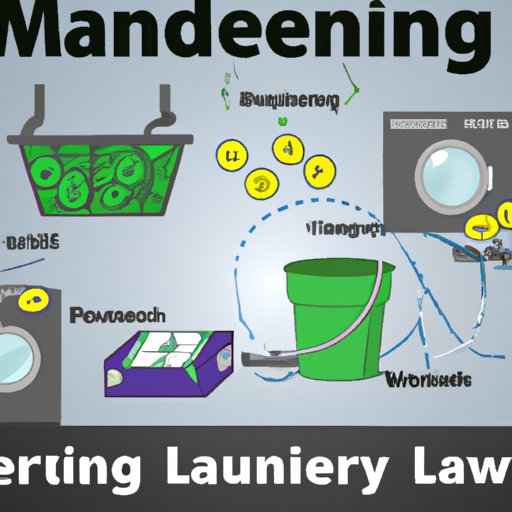Introduction
Money laundering is a serious criminal activity that seeks to disguise the origins of illegally obtained funds. It is a global problem that has far-reaching consequences for businesses, governments, and individuals. In this article, we will explore how money laundering works, examine the laws and regulations surrounding the crime, investigate the impact it has on the global economy, and investigate recent money laundering cases and their outcomes.
An Overview of Money Laundering: How It Works
Money laundering is the process of concealing the origins of illegally obtained money by transferring it through legitimate channels. The goal is to make it appear as if the money was earned or acquired through legal means. To accomplish this, criminals use a variety of techniques, including structuring, layering, and integration.
Structuring
Structuring is the practice of breaking up large amounts of money into smaller transactions to avoid detection by authorities. This technique is commonly used to avoid triggering currency transaction reports (CTRs), which must be filed when deposits or withdrawals over $10,000 are made. Criminals will often try to stay just below this threshold by making multiple deposits or withdrawals over a short period of time.
Layering
Layering is the second step in the money laundering process. This involves taking the money from the first stage and moving it through a series of complex transactions to obscure its origin. This can involve moving money through offshore accounts, using shell companies, or investing in high-risk investments.
Integration
The final stage of money laundering is integration. This involves taking the money from the previous steps and integrating it back into the legitimate financial system. This can be done through the purchase of real estate, luxury goods, or other investments that can be used to legitimize the money.
The Role of Banks and Financial Institutions in Money Laundering
Banks and other financial institutions are often unwitting participants in money laundering activities. Criminals will use these institutions to move and hide their funds, often exploiting weaknesses in the institution’s anti-money laundering (AML) procedures. For example, criminals may open multiple accounts under different names to make it more difficult to trace the source of the funds.

Examining the Laws and Regulations Surrounding Money Laundering
There are a number of laws and regulations in place to help combat money laundering. These include the Bank Secrecy Act (BSA), the USA PATRIOT Act, and the Anti-Money Laundering Act of 2001. The BSA requires financial institutions to report suspicious activity, while the USA PATRIOT Act expands the scope of the BSA to include terrorism financing. The Anti-Money Laundering Act of 2001 also requires financial institutions to maintain records of customer transactions.
In addition to federal laws, many states have adopted their own anti-money laundering legislation. These laws vary from state to state, but generally require financial institutions to report suspicious activity and maintain records of customer transactions.
Violations of these laws can result in a range of penalties, including fines, asset forfeitures, and jail time. In some cases, the penalties may be even harsher if the crime is related to terrorism financing.

Understanding the Impact of Money Laundering on the Global Economy
Money laundering has a significant impact on the global economy. It reduces tax revenues, undermines public trust in the financial system, and can be used to finance terrorism. Let’s take a closer look at each of these impacts.
Effects on Tax Revenue
Money laundering reduces the amount of taxes collected by governments. According to a study by the International Monetary Fund, the total amount of money laundered globally is estimated to be between 2-5% of global GDP, or roughly $1.6 trillion. This represents a major loss of potential tax revenue for governments around the world.
Impact on Financial System
Money laundering can also undermine public trust in the financial system. When criminals are able to use the banking system to move and hide their funds, it makes it more difficult for law enforcement to detect and prosecute them. This can lead to decreased confidence in the banking system, which can have a negative impact on the broader economy.
Potential for Terrorism Financing
Finally, money laundering can be used to finance terrorism. Terrorists need access to large amounts of money to fund their operations and money laundering provides them with a way to acquire these funds without raising suspicion. According to a report by the United Nations Office on Drugs and Crime, terrorist organizations generate an estimated $300 million to $500 million annually from money laundering activities.

Investigating Recent Money Laundering Cases and Their Outcomes
Money laundering continues to be a major problem around the world. In recent years, there have been a number of high-profile cases that have highlighted the extent of the problem. Here are a few examples of these cases and the lessons they have taught us.
Examples of High-Profile Cases
One of the most prominent recent money laundering cases was the “Panama Papers” scandal. This involved a massive leak of confidential documents from a Panamanian law firm that revealed a network of shell companies being used to hide money and evade taxes. Another notable case was the “Russian Laundromat” scandal, which exposed a massive international money laundering scheme involving Russian oligarchs and banks from around the world.
Lessons Learned from These Cases
These cases illustrate the importance of strong anti-money laundering regulations and enforcement. They also demonstrate the need for greater transparency in the financial system, as well as increased cooperation between countries to better combat money laundering. Finally, they show the importance of educating people about the dangers of money laundering and the need to remain vigilant against this type of criminal activity.
Conclusion
Money laundering is a global problem that has far-reaching consequences for businesses, governments, and individuals. In this article, we explored how money laundering works, examined the laws and regulations surrounding the crime, and investigated the impact it has on the global economy. Finally, we looked at recent money laundering cases and the lessons we can learn from them.
The best way to prevent money laundering is for governments, banks, and financial institutions to work together to create strong regulations and enforcement measures. Additionally, it is important to educate people about the dangers of money laundering and the need to remain vigilant against this type of criminal activity.
(Note: Is this article not meeting your expectations? Do you have knowledge or insights to share? Unlock new opportunities and expand your reach by joining our authors team. Click Registration to join us and share your expertise with our readers.)
